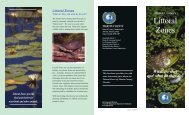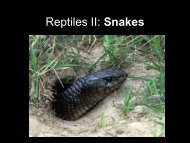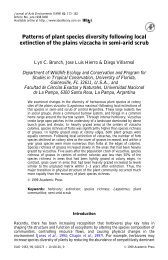BoletÃÂn Chileno de OrnitologÃÂa - Wildlife Ecology and Conservation ...
BoletÃÂn Chileno de OrnitologÃÂa - Wildlife Ecology and Conservation ...
BoletÃÂn Chileno de OrnitologÃÂa - Wildlife Ecology and Conservation ...
You also want an ePaper? Increase the reach of your titles
YUMPU automatically turns print PDFs into web optimized ePapers that Google loves.
ARTICULOS13also monitored nests in the vegetation of fencerows,roadsi<strong>de</strong>s, <strong>and</strong> pastures near the forest study sites.The native old growth rainforest in the forestfragments was characterized by emergent Nothofagusnitida <strong>and</strong> Eucryphia cordifolia, with a canopy ofDrimys winteri, Weinmannia trichosperma, severalmyrtaceous species, <strong>and</strong> the conifer Podocarpusnubigena (Armesto <strong>and</strong> Figueroa 1987, Veblen et al.1996). The un<strong>de</strong>rstory inclu<strong>de</strong>d <strong>de</strong>nse Chusquea spp.(bamboo) thickets <strong>and</strong> tree saplings. The treecomposition of the forest in the national park wascharacterized by more Aextoxicon punctatum <strong>and</strong>myrtaceous species (including Luma apiculata <strong>and</strong>Myrceugenia ovata var. ovata) <strong>and</strong> less P. nubigena,<strong>and</strong> epiphytic bromeliads were common. Unlike mostforest fragments, the disturbance within the forest ofthe national park was very low, with human activitylimited to one hiking trail.The vegetation of roadsi<strong>de</strong>s <strong>and</strong> fencerowstypically consisted of small D. winteri, Berberis spp.,Raphithamnus spinosus, Buddleja globosa, Fuchsiamagellanica, Ulex europaeus (introduced), <strong>and</strong> variousother shrubs or small trees. Pastures had some scatteredst<strong>and</strong>s of myrtaceous <strong>and</strong> D. winteri saplings, <strong>and</strong> thesame shrubs as those found in fencerows.Nest success. We recor<strong>de</strong>d nesting data forthe austral springs of 1993-1999. All the observedspecies had begun nesting in October except the fíofío(Elaenia albiceps), which began in November.Nests were found by watching the behavior of adultscarrying nesting material or food to consistent locationsor sometimes by acci<strong>de</strong>ntally flushing a bird from anest. Nests were monitored every 1-3 days until theyoung fledged or the nest failed. A nest was consi<strong>de</strong>redto be (1) active, if there was evi<strong>de</strong>nce that eggs oryoung were being ten<strong>de</strong>d; (2) <strong>de</strong>predated, if the nestshowed obvious signs of <strong>de</strong>predation (egg shellfragments or torn nesting material) or if nest contentswere missing before possible fledging age (based onplumage <strong>de</strong>velopment <strong>and</strong> compared to known-agebirds); (3) failed due to weather, if the nest showedobvious signs of disturbance from wind, rain, orflooding; (4) ab<strong>and</strong>oned, if the nest was not ten<strong>de</strong>dbut cause of failure was unknown; or (5) successful, ifadults were observed feeding ≥ 1 nestling nearfledging. Nests ab<strong>and</strong>oned during nest building or notused for reproduction were exclu<strong>de</strong>d from analyses.Nest success was calculated using theMayfield method (1961, 1975) as <strong>de</strong>tailed by Hensler<strong>and</strong> Nichols (1981), including nests with uncertainfate (Manolis et al. 2000), for samples of sufficientminimum size. We used average values for clutchsizes, incubation periods, <strong>and</strong> nestling periods,appropriate for each species, to <strong>de</strong>termine observationdays in each period of the nesting cycle (Johnson1967, our unpubl. data) to calculate overall Mayfieldpercent nesting success for species with a<strong>de</strong>quatesample sizes. For calculations of percent nest success,we inclu<strong>de</strong>d the period of egg laying as part of theincubation period. For selected cases with smallsample sizes, we perforce report ‘apparent nestsuccess’ as a simple percent of total nests found.Although this value is subject to some bias, especiallyin comparisons with other studies (e.g., Jehle et al.2004), it is sufficient to indicate relative levels ofsuccess within this study.Statistical analyses. Daily survival rates forsamples of sufficient size for the Mayfield method werecompared with computer program CONTRAST, whichuses a Chi-square analysis with multiple comparisons(Hines <strong>and</strong> Sauer 1989, Sauer <strong>and</strong> Williams 1989).Preliminary analyses indicated no annual differencesamong the years for which sample sizes were a<strong>de</strong>quate,so subsequent analyses pooled data from all years. Wetested for differences in nest characteristics ofsuccessful <strong>and</strong> <strong>de</strong>predated forest nests usingnonparametric univariate statistics (Wilcoxon twosampletest, SAS Institute Inc. 2000). To examine nestsuccess near forest edges, we assigned nests to distancecategories <strong>and</strong> found that daily mortality rates werehighest within 20m of the edge, so we then used thatdistance for comparisons of edge vs. interior nestsuccess. All percent data were angular-transformedbefore analysis. For post-hoc multiple pairwisecomparisons, we used an adjusted alpha value tocontrol for experiment-wise error (Zar 1999).RESULTSHabitat distribution. Three commonspecies (see Table 1) nested in forest fragments <strong>and</strong>the national park (E. albiceps, n = 61 nests; S.sephanoi<strong>de</strong>s, n = 122; T. falckl<strong>and</strong>ii, n = 51), <strong>and</strong>occasionally (n = 1, 6, <strong>and</strong> 4 respectively) inshrubby habitats. Cachuditos (Anairetes parulus,n = 14) nested within forest fragments <strong>and</strong> at theforest edge of the national park but were notobserved in the forest interior of the national park.The viudita (Coloramphus parvirostris, n = 9)nested in both small <strong>and</strong> large forest fragments thatwere relatively undisturbed by foot traffic or


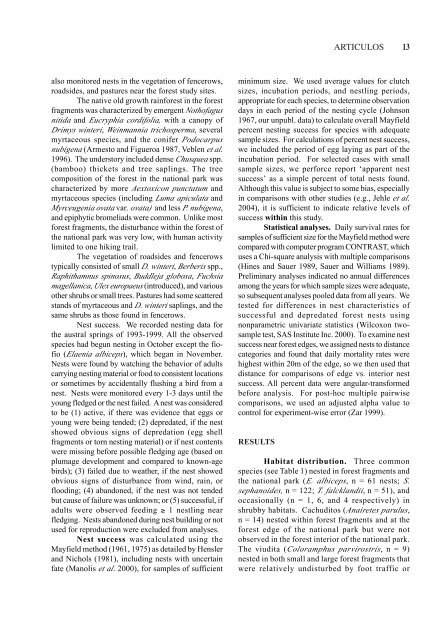
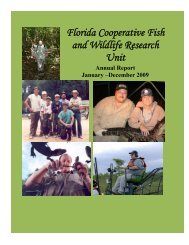
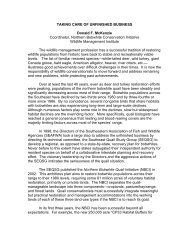
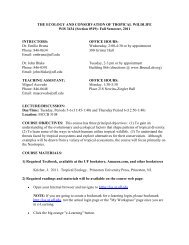
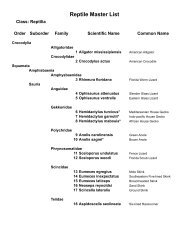

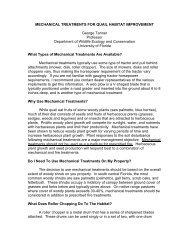
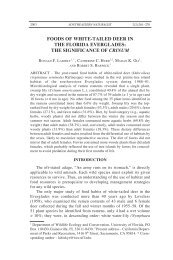
![rivers,lakes.ppt [Read-Only]](https://img.yumpu.com/43445703/1/190x245/riverslakesppt-read-only.jpg?quality=85)
